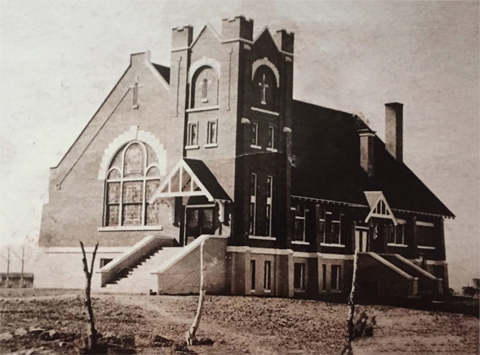(Picture of a Cowboy standing on the porch of his home. Caption says: John Edwards – grandson of Gwennie Davis Edwards and John Edwards. Photo taken in 1980 in front of the little house where Titus Davis Sr. lived until his death. John Edwards still lives on this property which was originally built and owned by his grandfather – John Edwards. Willard, Utah)
The Poet of Willard Loves to Labor, Part of ‘Good Life’
By Clark Lobb, Tribune Staff Writer. (Utah Journey: Willard)
Willard – Box Elder County – You have to set the scene when you talk about John Edwards.
You have to set the jewel in its mounting.
It’s a hot July day, late in the morning, and there seems to be no one at home.
You are fascinated and pleased as you walk past the 112-year-old adobe and stone house.
But you’re pretty sure John is not there. So you walk to the rear of the property, spot what appears to be an abandoned cabin.
But it’s not abandoned. There’s a bed inside. And other evidence that someone – undoubtedly John – has been living there.
The door is open, but there’s no sign of John.
“Hello,” you holler. “Anyone here?”
Answers From Orchard
“Hello,” comes the answer from somewhere in the cherry orchard.
A few more steps among the heavily laden fruit trees – and there he is, nearly at the top of one of the trees.
He loads his bucket with cherries, says he welcomes a respite from his labors and sits down with you on the stoop of his cabin.
“Always believed in work,” he says, doffing his paint-splatter hat and wiping his brow.
“The secret of a good life is to balance out mental and physical endeavors.”
Writings Win Acclaim
“The Poet of Willard,” whose writings have received wide acclaim, gives his all in physical labor despite his 67 years.
“I can outwork any young bucko in town,” he proclaims.
It was then he realized he might have overlooked some of the amenities.
“You’ve come to visit,” he says with a little surprise in his voice. We had made a firm appointment, but we had the feeling John was a little surprised that we showed up on time, if at all.
‘Everybody’s Welcome’
“Step in, then,” he adds. You’re welcome. Everybody’s welcome here.”
“This, “ he said of the cabin and its unfinished furniture, “is the last remnant of my great-grandfather and my grandfather.”
“The cabin was built in about 1900,” he reports. “It’s my getaway. During the summer I get away here to labor and meditate.”
One of his efforts in prose –”written when I was a farm boy of 16” – won honors at the 1939 World’s Fair in New York City and then was sent to the Library of Congress and finally to Rockefeller Center.
But a writer’s life was not for John.
Has Too Much Energy
“I’m too gung ho physically,” he explains. “I couldn’t settle down to condemn myself to the trials of a writer. Always had too much energy to settle down.”
Practicing what he preaches concerning balance, John has divided his farm life with life in various cities, including Salt Lake City.
The former railroad track layer (“a gandy dancer”), rancher, cement finisher and trench digger says he gets “most satisfaction from a hard day of physical labor.”
‘…I’ve written a piece that I get extreme mental exhilaration – almost euphoria.’
‘There’s Nothing Like It’
“There’s nothing like it. I can’t describe it. It’s the zenith of intellectual stimulation.”
Yes, this man is a jewel – not a polished gem, perhaps, but a jewel nevertheless.
He is an avid reader, sitting for hours at night in another structure on the acre of property known as the “Doll House.” It once was just that – a doll house or play house for John’s Aunt Mabel.
John has a telephone and a lamp in here, a lamp used to pore over books on most any subject – archaeology, mineralogy, history.
“I read more about the pyramids last winter than most would read in two lifetimes,” he says with a grin. “Now, if could only remember all of it.”
Enjoys the Teasing
And he laughed as he enjoyed teasing himself and us.
Television, except for news and “some special documentaries,’ is not for John.
“The ordinary shows make me puke,” says John, not a man to mince words.
He attended the University of Utah in 1940, but he quit to join – as he put it – “the University of Hard Knocks.”
John never married. He lives in a sort of detente with a sister, Gladys Schroeder, who resides in the big house.
Concern About Sister
Despite John’s “living out” policy, he also has concerns about his sister. He says he named his cabin the “Long Branch” because Gladys “Is so crazy about that Matt Dillon show, “Gunsmoke.”
His feelings toward modern art parallel his overall appraisal of television.
“What is the strongest word I can find for Picasso’s work?” muses John.
“Abominable!”
“I wouldn’t give you five cents for it. I like the more traditional art – landscapes and portraits. I love cartoons!”
Loves to Work Hard
And that is John Edwards, a man with many ideas, a man who loves to work hard, who loves to meditate, who loves to write.
And sitting on that cabin porch, the old wagon wheel in back of the chair, the July morning cool under the cherry trees, lives a man who has learned the answer to the $64 question.
He is, indeed, at peace with the world – and with himself!
